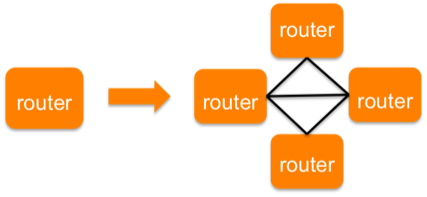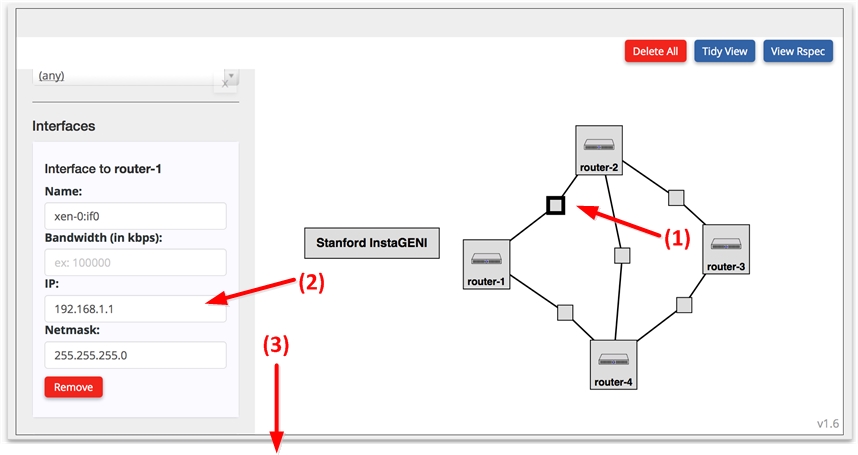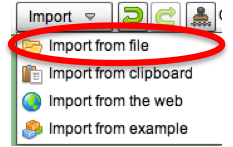A Tutorial on Systematic Experimental Design

1. Software Configuration
Once we have installed the software on the VM, we may need to configure the software, and automate the configuration process for every node used in an experiment. For this tutorial, since we are setting a virtual routing environment, we will need to configure the routing protocol (e.g., OSPF protocol) for XORP. Again, let's start with the smallest reasonable topology, which is a four-router virtual topology as shown below. The reason that we chose the four-router topology is that we need at least one pair of routers that are not directly connected to each other and each router must have at least two virtual interfaces.
a. Create Virtual Network
As we have mentioned, a four-router topology is the smallest topology to configure and verify the OSPF routing. In this part, we illustrate how to create a virtual network with four virtual routers.
i. Create VMs and Virtual Links
Create four VMs from the same InstaGENI aggregate and add the links. Modify each VM's name, set the Sliver Type to emulab-xen, and load the custom image by following the steps in the Load Custom Image section. You may use the the value https://www.instageni.clemson.edu/image_metadata.php?uuid=5417bcef-224e-11e4-aa5a-000000000000 in the Disk Image option for each router in this topology.
The network configuration address assignment is given below:
router-1 (.1) <-----> router-2 (.2) on 192.168.1.0/24 router-2 (.1) <-----> router-3 (.2) on 192.168.2.0/24 router-3 (.1) <-----> router-4 (.2) on 192.168.3.0/24 router-4 (.1) <-----> router-1 (.2) on 192.168.4.0/24 router-2 (.1) <-----> router-4 (.2) on 192.168.5.0/24
ii. Configure Virtual Interfaces
Configure the virtual interfaces' IP addresses of each link as outlined in the network configuration address assignment list above:
(1) Click on the link to be configured
(2) Enter Address for one interface
(3) Scroll down and enter address for the other interface part of the link
(4) Repeat for each of the list shown in the network configuration address assignment list
iii. Save the Current RSpec
For version control purposes, it is important to save the resource request specification (RSpec) at each step. Thus, once we have defined the topology above, we select the Download button to save an intermediate version of your RSpec.
| The download command does not allow naming it simply uses the slice name to generate a RSpec file. We have save a copy of this RSpec, which you may choose to download, available at here |
You may now reserve your resources by scrolling to the bottom of the Add Resources page ans clicking on the Reserve Resources button:
b. Manually Configure OSPF for XORP
In this tutorial we configure each VM as a virtual router running the OSPF routing protocol. Examples of XORP configurations can be found at XORPExamples. For each VM running as a software router, the OSPF configuration file will be named ospfd.conf and is stored in /etc/xorp/. We provide sample OSPF configuration file that can be downloaded to each router.
Download the sample OSPF configuration to router-1:
sudo mkdir /etc/xorp cd /etc/xorp sudo wget http://groups.geni.net/geni/raw-attachment/wiki/GENIExperimenter/Tutorials/SystematicExprCaseStudy/SmallTopo/DesignSetup/r1-ospf.conf sudo mv r1-ospf.conf ospfd.conf
The interface information in the sample files may be different from the routers interfaces, you must check that the interface information is properly mapped in the ospfd.conf on each router before you start xorp.
There are several key configuration items in the OSPF configuration file for router-1.
Interface Information:
interface eth1 {
description: "virtual interface-eth1"
disable: false
discard: false
vif eth1 {
disable: false
address 192.168.4.2 {
prefix-length: 24
disable: false
}
}
}
interface eth2 {
......
}
OSPF Metrics:
protocols {
ospf4 {
router-id: 192.168.1.1
area 0.0.0.0 {
area-type:"normal"
interface eth1 {
vif eth1 {
address 192.168.4.2 {
interface-cost 10
hello-interval 5
router-dead-interval 10
disable: false
}
}
}
interface eth2 {
......
}
}
}
}
To simplify the configuration process, we assume the interface-cost and the hello-interval are both set to 10 seconds for every virtual interface. The main information needed from each node is the virtual interface's address and its prefix-length, as well as the router's router-id that is required for the protocol section in the configuration file.
Now download the configuration on the remaining routers and verify that the interfaces addresses are properly mapped in the ospfd.conf file.
Download the sample OSPF configuration to router-2 and check interfaces address mappings:
sudo mkdir /etc/xorp cd /etc/xorp sudo wget http://groups.geni.net/geni/raw-attachment/wiki/GENIExperimenter/Tutorials/SystematicExprCaseStudy/SmallTopo/DesignSetup/r2-ospf.conf sudo mv r2-ospf.conf ospfd.conf
Download the sample OSPF configuration to router-3 and check interfaces address mappings:
sudo mkdir /etc/xorp cd /etc/xorp sudo wget http://groups.geni.net/geni/raw-attachment/wiki/GENIExperimenter/Tutorials/SystematicExprCaseStudy/SmallTopo/DesignSetup/r3-ospf.conf sudo mv r3-ospf.conf ospfd.conf
Download the sample OSPF configuration to router-4 and check interfaces address mappings:
sudo mkdir /etc/xorp cd /etc/xorp sudo wget http://groups.geni.net/geni/raw-attachment/wiki/GENIExperimenter/Tutorials/SystematicExprCaseStudy/SmallTopo/DesignSetup/r4-ospf.conf sudo mv r4-ospf.conf ospfd.conf
c. Start XORP and Verify Routing
i. Start XORP Process
First, we must add the xorp user group. Login to each router and run the following command:
sudo groupadd xorp
Start XORP by specifying the routing protocol configuration file.
lnevers@router-1:/etc/xorp$ cd /usr/local/xorp/sbin/ lnevers@router-1:/usr/local/xorp/sbin$ sudo ./xorp_rtrmgr -b /etc/xorp/ospfd.conf -l /tmp/xorp_rtrmgr_log -d Not doing pidfile... lnevers@router-1:/usr/local/xorp/sbin$
Verify the XORP process is running:
lnevers@router-1:/usr/local/xorp/sbin$ ps -ef | grep xorp root 9658 1 0 06:06 pts/0 00:00:00 xorp_fea root 9659 1 0 06:06 pts/0 00:00:00 xorp_rib root 9660 1 0 06:06 pts/0 00:00:00 xorp_policy root 9661 1 0 06:06 pts/0 00:00:00 xorp_ospfv2 root 9662 1 0 06:06 ? 00:00:00 ./xorp_rtrmgr -b /etc/xorp/ospfd.conf -l /tmp/xorp_rtrmgr_log -d lnevers@router-1:/usr/local/xorp/sbin$
Now you have routing running on all four router!
If you need to stop XORP, use the kill command as shown below to stop each the 5 xorp processes:
ps -ef | grep xorp_ | /usr/bin/awk '{ if ( $1 == "root" ) {print "sudo kill -9 " $2}}' | sh
ii. Verify Routing
Login to router-1 and view the OSPF routing table:
xuanliu@router-1:/usr/local/xorp/sbin$ sudo ./xorpsh Welcome to XORP v1.8.5 on router-1.xuan-wiki-prep.ch-geni-net.instageni.stanford.edu Version tag: 00000000 Build Date: 2014-06-05 17:11 64-bit root@router-1.xuan-wiki-prep.ch-geni-net.instageni.stanford.edu> show route table ipv4 unicast ospf 192.168.2.0/24 [ospf(110)/20] > to 192.168.1.2 via eth2/eth2 192.168.3.0/24 [ospf(110)/20] > to 192.168.4.1 via eth1/eth1 192.168.5.0/24 [ospf(110)/20] > to 192.168.1.2 via eth2/eth2
Login to router-3 and view the OSPF routing table:
xuanliu@router-3:/usr/local/xorp/sbin$ sudo ./xorpsh Welcome to XORP v1.8.5 on router-3.xuan-wiki-prep.ch-geni-net.instageni.stanford.edu Version tag: 00000000 Build Date: 2014-06-05 17:11 64-bit root@router-3.xuan-wiki-prep.ch-geni-net.instageni.stanford.edu> show route table ipv4 unicast ospf 192.168.1.0/24 [ospf(110)/20] > to 192.168.2.1 via eth2/eth2 192.168.4.0/24 [ospf(110)/20] > to 192.168.3.1 via eth1/eth1 192.168.5.0/24 [ospf(110)/20] > to 192.168.2.1 via eth2/eth2 root@router-3.xuan-wiki-prep.ch-geni-net.instageni.stanford.edu>
Since router-1 and router-3 are not directly connected, by OSPF routing, we should be able to run ping and traceroute between them.
xuanliu@router-3:/usr/local/xorp/sbin$ ping 192.168.1.1 PING 192.168.1.1 (192.168.1.1) 56(84) bytes of data. 64 bytes from 192.168.1.1: icmp_req=1 ttl=63 time=2.15 ms 64 bytes from 192.168.1.1: icmp_req=2 ttl=63 time=1.45 ms 64 bytes from 192.168.1.1: icmp_req=3 ttl=63 time=1.41 ms ^C --- 192.168.1.1 ping statistics --- 3 packets transmitted, 3 received, 0% packet loss, time 2003ms rtt min/avg/max/mdev = 1.411/1.673/2.152/0.342 ms xuanliu@router-3:/usr/local/xorp/sbin$ traceroute 192.168.1.1 traceroute to 192.168.1.1 (192.168.1.1), 30 hops max, 60 byte packets 1 router-2-lan1 (192.168.2.1) 0.652 ms 0.595 ms 0.563 ms 2 router-1-lan0 (192.168.1.1) 1.146 ms 1.106 ms 1.076 ms xuanliu@router-3:/usr/local/xorp/sbin$
d. Automate OSPF Configuration
By understanding the syntax of the OSPF configuration file for XORP, we are able to automate the OSPF configuration for every virtual router in a topology, assuming these virtual routers are identical. You can download the automation scripts from XORPAutoStart.
i. Test the Automation
To test it, you will need to login to each router (e.g., router-3) and run the start-xorp.sh. You will see the output similar to the following:
dhcp89-69-127:~ xliu$ ssh -p 30781 -i /Users/xliu/.ssh/id_rsa xuanliu@pc3.instageni.stanford.edu Welcome to Ubuntu 12.04 LTS (GNU/Linux 3.2.0-56-generic x86_64) * Documentation: https://help.ubuntu.com/ Last login: Mon Jun 30 14:56:51 2014 from 128.89.69.127 xuanliu@router-3:~$ cd /local xuanliu@router-3:/local$ sudo wget https://github.com/GENI-NSF/geni-tutorials/blob/master/SystematicExprCaseStudy/xorp_autostart.tar.gz xuanliu@router-3:/local$ sudo tar -zxvf xorp_autostart.tar.gz xuanliu@router-3:/local/xorp_autostart$ /bin/bash start-xorp.sh router-3.xuan-wiki-prep.ch-geni-net.instageni.stanford.edu 2014-07-01 06:56:28 AM XORP dir exist xorp is already added to the group xorp is running, stop it first XORP is starting ...... Not doing pidfile...
The key procedure is to obtain the virtual interface's address and its prefix of the subnet information.
In the install script start-xorp.sh, the Following components are the key parts to generate ospfd.conf.
- Get Hostname and virtual interface information, and store it into a file (
vm_info.txt)hostname | sudo tee vm_info.txt > /dev/null /sbin/ifconfig | egrep 'eth|inet addr' | sudo tee -a vm_info.txt > /dev/null
A samplevm_info.txtis available at SampleVMInfo
- Create
ospfd.confby running anawkscript, available from heresudo /usr/bin/awk -f $ABS_PATH/ospfd-conf-gen.awk $vm_info_file "$timestamp" 24 | sudo tee $ABS_PATH/ospfd.conf > /dev/null
A sampleospfd.confis available at SampleOSPFConf
- Start
XORPProcess$sudo ./xorp_rtrmgr -b /etc/xorp/ospfd.conf -l /tmp/xorp_rtrmgr_log -d
The complete shell script to wrap up the above procedures is available at StartXORP
| Please go to HowToWriteInstallScript for details on how to write an install script. |
Next we are going to install the automate script as an install script at the postboot stage.
| If you plan to use the same slice to do the next step, please delete your existing resources in your slice at this time, otherwise you can create a new slice to continue. |
e. Install Script
Launch Flack for your slice, and import the RSpec 4node-v1.rspec we just saved.
Click Import and select Import from file from the pull-down list, then select 4node-v1.rspec from the location where you have just saved to, and confirm it. You will see the four-node topology on your canvas, and each node has been configured to have the custom image.
Now, we are ready to add an install script by editing the node property. For each node, click  to see the node information. By clicking
to see the node information. By clicking  , we are able to add a service that usually refers to an install script. In this tutorial, we will add an install script called
, we are able to add a service that usually refers to an install script. In this tutorial, we will add an install script called xorp_autostart.tar.gz, by entering the link https://github.com/GENI-NSF/geni-tutorials/blob/master/SystematicExprCaseStudy/xorp_autostart.tar.gz, and the install path is set as /local. By clicking  , we can add the commend that execute the install script. In the execute box, we enter
, we can add the commend that execute the install script. In the execute box, we enter /bin/bash /local/xorp_autostart/start-xorp.sh, and the shell type is sh.
Once we added the service and the execute service in Flack, apply the changes and submit the VM reservation request, the OSPF configuration file will be automatically created and the XORP will be started at router-1 once it is initialized.
Repeat the same procedures for the other three routers (i.e., router-2, router-3, router-4), and then submit the request. When all resources are ready, Save the RSpec as 4node-v2.rspec at this stage, we will load this RSpec in the next step to get the same setup. (You can download a sample RSpec for 4node-v2.rspec at here)
Setting up the install script will automate installation or configuration process at every node's postboot stage, and we do not need to login to every node to run start-xorp.sh manually.
2. Impact to Request RSpec
Whenever we make a change to node information or link information in Flack, the user request RSpec is modified accordingly. In other words, we can rely on Flack to easily modify the request RSpec.
Now let's take a look at how the steps Load a Custom Image and Adding Install Scripts will modify the request RSpec. For instance, before adding the custom image and install scripts, the RSpec describing router-1 was like:
<node client_id="router-1" component_manager_id="urn:publicid:IDN+instageni.stanford.edu+authority+cm" component_id="urn:publicid:IDN+instageni.stanford.edu+node+pc3" component_name="pc3" exclusive="false">
<vnode name="pcvm3-3" xmlns="http://www.protogeni.net/resources/rspec/ext/emulab/1"/>
<location latitude="37.43" longitude="-122.17" country="US"/>
<interface client_id="xen-0:if0">
<ip address="192.168.1.1" netmask="255.255.255.0" type="ipv4"/>
<flack:interface_info addressBound="true" bound="false"/>
</interface>
<interface client_id="xen-0:if1">
<ip address="192.168.4.2" netmask="255.255.255.0" type="ipv4"/>
<flack:interface_info addressBound="true" bound="false"/>
</interface>
<flack:node_info x="150" y="407" unbound="true"/>
</node>
First, when we added the custom image (see Load a Custom Image), a new tag <sliver> will be added to router-1's RSpec, which is
<sliver_type name="emulab-xen">
<disk_image url="https://www.instageni.clemson.edu/image_metadata.php?uuid=5417bcef-224e-11e4-aa5a-000000000000"/>
</sliver_type>
Secondly, when we added the install scripts (see Adding Install Scripts), a new tag <service> will be added to router-1's RSpec, which is
<services>
<execute command="/bin/bash /local/xorp_autostart/start-xorp.sh" shell="sh"/>
<install install_path="/local" url="https://github.com/GENI-NSF/geni-tutorials/blob/master/SystematicExprCaseStudy/xorp_autostart.tar.gz"/>
</services>
This indicates that we can add custom image and postboot scripts by directly modifying the request RSpec, this is helpful when we have a larger topology.
3. Script to Capture Routing Table Periodically
In this tutorial, one metric we would like to evaluate is how often the routing table will be updated when there is a link/node failure. To emulate a link failure, we can disable the virtual interfaces, and to emulate a virtual router failure, we can stop the XORP process at the virtual router. A short script (downloaded from here is available to be loaded as an install script.
Delete any existing resources or create a new slice, LOAD the RSpec 4node-v2.rspec, and add a new install service to every node in Flack. Now, the service portion for each node becomes to
<services>
<execute command="/bin/bash /local/xorp_autostart/start-xorp.sh" shell="sh"/>
<install install_path="/local" url="https://github.com/GENI-NSF/geni-tutorials/blob/master/SystematicExprCaseStudy/xorp_autostart.tar.gz"/>
<install install_path="/local" url="https://github.com/GENI-NSF/geni-tutorials/blob/master/SystematicExprCaseStudy/xorp_run.tar.gz"/>
</services>
After adding the new install script to every node, send the resource reservation request. When all nodes are ready to login, we save the new modified RSpec as 4node-v3.rspec. (You can download a sample RSpec for 4node-v3.rspec at here)
In the next step, we will add two end hosts to current four-node topology, so now we can delete existing resources from the current slice.
4. Add End Hosts and Install iperf
Once we have verified the routing functions for the virtual router, we add end hosts to validate the end-to-end communication. As the figure shows below, we create the same four-node topology by loading 4node-v3.rspec in Flack, and create two more VMs as a client and a server, and add two virtual links. The links between end-hosts and edge routers are configured as below:
client ----- router-1: 192.168.10.0/24 server ----- router-3: 192.168.20.0/24 client: 192.168.10.11 server: 192.168.20.10
For client and server, we select regular Ubuntu 12.04 OS in the node information, so we need to install iperf separately. In this example, there are only two hosts need iperf installed, so one option is to login to each host, and manually install it by running
sudo apt-get install iperf
Or, we can also write a script to install iperf to the client and server, load it as an install script by following the same steps as we just did for XORP. The install scripts for client and server can be downloaded from here. An sample RSpec with iperf install script and execute command can be downloaded at `4node-v4.rspec`.
SAVE the new RSpec to 4node-v4.rspec, when all nodes have been reserved.
Attachments (27)
- 4node-config.png (23.4 KB) - added by 10 years ago.
- 4node-topo.png (54.8 KB) - added by 10 years ago.
- info.jpg (3.1 KB) - added by 10 years ago.
- add-service-btn.png (5.4 KB) - added by 10 years ago.
- add-exe-serv-btn.png (6.0 KB) - added by 10 years ago.
- node-install-service.png (99.1 KB) - added by 10 years ago.
- r1-ospf.conf (1.3 KB) - added by 10 years ago.
- r2-ospf.conf (1.7 KB) - added by 10 years ago.
- r3-ospf.conf (1.3 KB) - added by 10 years ago.
- r4-ospf.conf (1.7 KB) - added by 10 years ago.
- ospfd-conf-gen.awk (2.2 KB) - added by 10 years ago.
- vm_info.txt.example (490 bytes) - added by 10 years ago.
- ospfd.conf.example (1.3 KB) - added by 10 years ago.
- start-xorp.sh (2.4 KB) - added by 10 years ago.
- initial_install.sh (388 bytes) - added by 10 years ago.
- export-to-file.jpg (63.6 KB) - added by 10 years ago.
- import-rspec-from-file.png (28.5 KB) - added by 10 years ago.
- 4node-add-endhosts.png (45.1 KB) - added by 10 years ago.
- lan-config.png (46.5 KB) - added by 10 years ago.
- 4node-v1.rspec (40.2 KB) - added by 10 years ago.
- 4node-v2.rspec (41.6 KB) - added by 10 years ago.
- 4node-v4.rspec (51.9 KB) - added by 10 years ago.
- 4node-v3.rspec (43.2 KB) - added by 10 years ago.
- SmallTopo.jpg (65.8 KB) - added by 8 years ago.
- ConfigIF.jpg (91.8 KB) - added by 8 years ago.
- SaveRSpec.jpg (63.7 KB) - added by 8 years ago.
- ReserveResources.jpg (17.5 KB) - added by 8 years ago.
Download all attachments as: .zip








